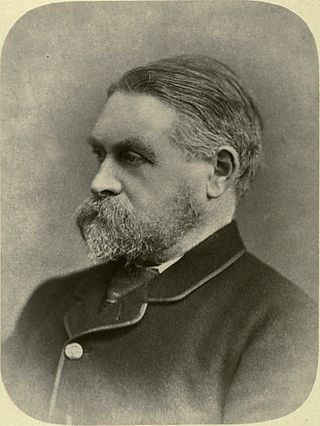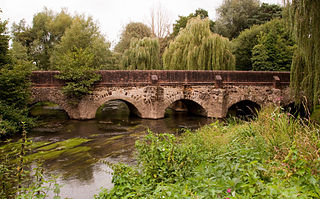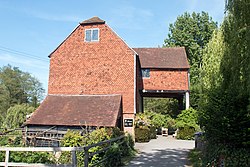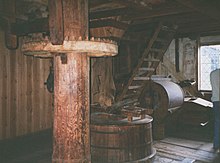
Haxted Watermill is a much-restored Grade II listed watermill in Surrey, England, close to the border with Kent, and is powered by the River Eden.

Shalford is a village and civil parish in the Guildford district, in Surrey, England on the A281 Horsham road immediately south of Guildford. It has a railway station which is between Guildford and Dorking on the Reading to Gatwick Airport line. In 2011 the parish had a population of 4,142.

The River Eden is a tributary of the River Medway in south east England. It rises at the foot of the North Downs escarpment near Titsey in Surrey and runs initially southwards through Oxted before turning eastwards to enter Kent. After flowing through Edenbridge and passing Hever Castle, the Eden meets the Medway at Penshurst.

Robert Alfred Cloyne Godwin-Austen FRS was an English geologist.

Lieutenant-Colonel Henry Haversham Godwin-Austen FRS FZS FRGS MBOU, known until 1854 as Henry Haversham Austen, was an English topographer, surveyor, naturalist and geologist.

Chilworth is a village in the Guildford borough of Surrey, England. It is located in the Tillingbourne valley, southeast of Guildford.

The Weald and Downland Living Museum is an open-air museum in Singleton, West Sussex. The museum is a registered charity. The museum covers 40 acres (16 ha), with over 50 historic buildings dating from 950AD to the 19th century, along with gardens, farm animals, walks and a mill pond.

Wonersh is a village and civil parish in the Waverley district of Surrey, England and Surrey Hills Area of Outstanding Natural Beauty. Wonersh contains three Conservation Areas and spans an area three to six miles SSE of Guildford.

The River Tillingbourne runs along the south side of the North Downs and joins the River Wey at Guildford. Its source is a mile south of Tilling Springs to the north of Leith Hill at grid reference TQ143437 and it runs through Friday Street, Abinger Hammer, Gomshall, Shere, Albury, Chilworth and Shalford. The source is a semi-natural uninhabited area. The catchment is situated on sandstone which has a low rate of weathering. The Tillingbourne is 24 km (15 mi) in length.

Ferguson's Gang, formed during a picnic at Tothill Fields in London in 1927, was an anonymous and somewhat enigmatic group that raised funds for the National Trust from 1930 to 1947.

Keston Windmill is a grade I listed Post mill in Keston, formerly in Kent and now in the London Borough of Bromley. The mill was built in 1716 and is conserved with its machinery intact but not in working order.

Ripple Windmill is a Grade II listed smock mill in Ringwould, Kent, England, that was built in Drellingore and moved to Ringwould in the early nineteenth century. Having been stripped of machinery and used as a television mast, it has been restored as a working windmill.

The River Wey is a main tributary of the River Thames in south east England. Its two branches, one of which rises near Alton in Hampshire and the other in West Sussex to the south of Haslemere, join at Tilford in Surrey. Once combined, the flow is eastwards then northwards via Godalming and Guildford to meet the Thames at Weybridge. Downstream the river forms the backdrop to Newark Priory and Brooklands. The Wey and Godalming Navigations were built in the 17th and 18th centuries, to create a navigable route from Godalming to the Thames.

Pixham is a chapelry within the parish of Dorking, Surrey on the near side of the confluence of the River Mole and the Pipp Brook to its town, Dorking, which is centred 1 km (0.6 mi) southwest. The town as a whole, uniquely in Surrey, has three railway stations; Pixham adjoins or is the location of two of the three; and is near the junction of the A24 and A25 main roads.
Margaret Steuart Pollard was a poet and bard of the Cornish language. She was the founding member of Ferguson's Gang, a secret society of supporters of the National Trust, who had their headquarters at Shalford Mill.
Rachel Pinney was a British medical doctor who pioneered therapeutic approaches to children's development in the 1960s which she termed "Creative Listening" and "Children's Hours". From 1927 to 1934 she was a member of the clandestine Ferguson's Gang, a group of eccentric philanthropists who donated money to the National Trust and other rural conservation appeals. In her alter-ego as Red Biddy, Pinney, cloaked and masked, delivered Ferguson's Gang's first donation to the National Trust offices in 1933. The delivery of £100 in silver for the endowment of Shalford Mill to the National Trust was reported in The Times. Unorthodox in many ways, Pinney kept a vow of silence on Wednesdays, and was a committed peace activist.
John Eric Miers Macgregor FRIBA FSA OBE, was a conservation architect with the Society for the Protection of Ancient Buildings. He was appointed an OBE in 1964 and the Esher Award in 1974 for his contribution to the repair of historic buildings.

Stoke Mill is a 19th century corn mill on the River Wey that has been converted into offices. It is situated off the Woking Road just north of Guildford town centre. It forms the centrepiece of a small group of buildings that includes the Grade II listed Stoke Mill House.

The Town Mill is a Grade II listed 18th-century watermill located in the centre of Guildford on the River Wey.

Many watermills lined the banks of the River Wey, England, from the 17th century, due to the river's ability to provide a reliable, year-round flow of water. These mills chiefly ground wheat, often referred to as corn, for flour and oats for animal feed though many were used in the production of other goods such as paper, cloth, leather, wire and gunpowder. The river was home to more mills per mile than anywhere else in Great Britain. The mill situated at Coxes Lock near Addlestone, Surrey, is the largest. There are many mills on the river's principal tributaries, such as the Tillingbourne, the Ock and some mills on the Whitmore Vale stream, Cranleigh Waters and Hodge Brook. The last commercial mill on the Tillingbourne, Botting's Mill at Albury, closed in 1991. Headley Water Mill, on the Wey South branch is still in business. Town Mill, Guildford still has a water turbine driven generator producing electricity for the town.


















